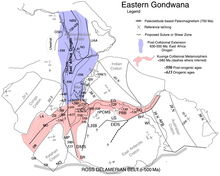Rayner Province
The Rayner Province , also known as the Rayner Complex, is a geological structure in what is now East Antarctica . It represents an orogenic belt that developed over a long period of time as a result of the collision of paleoproterozoic island arch terranas and archaic blocks. These merged into a continental complex in the course of the formation of the supercontinent Rodinia between 1050 and 1000 mya . The last tectonic event occurred at 540 mya during the collision of Proto-East Antarctica with Proto-India (Greater India).
Extension
Map of Antarctica
Location of the Enderbyland with the Napier complex, the Rayner province and the Lützow-Holm complex
Simplified geological map of the Enderbyland
The Rayner Province adjoins the Napier Complex and occurs in Enderbyland , Kempland and in the northern Prince Charles Mountains of the Mac Robertson Landdes . It connects the Napier Complex with the southern Prince Charles Mountains. The rock complexes of Rayner Province in the northern Prince Charles Mountains are bounded to the east by the granulite deposits in Prydz Bay and to the south by the southern Prince Charles Mountains.
Geodynamic development and rocks
The Rayner Province was formed during a tectonic phase from the Paleoproterozoic to the Mesoproterozoic . In this a collision regime prevails , in which between 2400 and 1500 mya mainly juvenile (newly formed) island arch crust parts accreted. Between 1400 and 1200 mya, tectonon-magmatic processes occurred, which are characterized by the settlement of plutonites and volcanic rocks of various petrographies . In the northern Prince Charles Mountains, granitic and gneissic protoliths were placed between 1040 and 930 mya, combined with metamorphoses and ductile deformations. Further tectono-thermal events occurred from 950 to 850 mya and between 550 and 500 mya. The latter phase corresponds to the Kuunga orogeny, during which, among other things, Proto-East Antarctica collided with Proto-India (Greater India) (see also → Merger of Proto-India, Proto-East Antarctica and Proto-Australia ).
The rock spectrum in the Rayner Province consists mainly of orthogneiss with amphibolitic to granulitic metamorphic facies. The igneous protoliths (parent rocks) are mostly products of an anatexis (partial melting) of the lower earth's crust . Geochemical properties of the igneous rocks indicate that they originate from high-temperature melting of a mantle plume and low-temperature melting of areas of the lithosphere . Furthermore paragneisses , pelitic , different mafic and calciumcarbonatische layers and Boudinagen represented. In addition, from 990 to 900 mya a supracrustal rock package formed from reworked granulites , which was deposited near the Napier complex on a mostly Proterozoic basement. Extensive Charnockite intrusions took place during a metamorphic phase along the eastern edge of Rayner Province.
The period and degree of metamorphosis along the eastern edge of Rayner Province as well as the Charnockite intrusions and the features of the protolithic crust correlate with the Indian Eastern Ghats (see also Proto-India ). They originally formed a tectonic unit that was attached to Proto-India (Greater India) before the Neoproterozoic . Late Neoproterozoic metamorphoses have been demonstrated to the east and south in Rayner Province and north in the Eastern Ghats (Kuunga orogeny).
Web links
- EV Mikhalsky, JW Sheraton, IV Kudriavtsev, SA Sergeev, VP Kovach, IA Kamenev and AA Laiba: The Mesoproterozoic Rayner Province in the Lambert Glacier area: its age, origin, isotopic structure and implications for Australia – Antarctica correlations. In: Geological Society , London, Special Publications, 383, 35–57, 20 May 2013, doi: 10.1144 / SP383.1 .
- LP Schwarz, SL Harley, SS SUN and MT McCulloch: The Rayner Complex of East Antarctica: complex isotopic systematics within a Proterozoic mobile belt. In: Journal of Metamorphic Geology , Volume 5, Issue 1, January 1987, doi: 10.1111 / j.1525-1314.1987.tb00366.x .
Individual evidence
- ↑ M. Satish-Kumar, T. Hokada, T. Kawakami and Daniel J. Dunkley: Geosciences research in East Antarctica (0 ° E – 60 ° E): present status and future perspectives. In: Geological Society , London, Special Publications, 308, 1-20, November 21, 2008, doi: 10.1144 / SP308.1 .
- ^ Prince Charles Mountains. In: Australian Government, Department of the Environment and Energy online article. Online article
- ↑ EV Mikhalsky and JW Sheraton: The Rayner tectonic Province of East Antarctica: compositional features and Geodynamic setting. In: Geotectonics , November 2011, Volume 45, Issue 6, pp 496-512, doi: 10.1134 / S0016852111060057 .
- ↑ GH Granthama, PH Macey, K. Horie, T. Kawakami, M. Ishikawa, M. Satish-Kumar and others: Comparison of the metamorphic history of the Monapo Complex, northern Mozambique and Balchenfjella and Austhameren areas, Sør Rondane, Antarctica: Implications for the Kuunga Orogeny and the amalgamation of N and S. Gondwana. In: Precambrian Research Volume 234, September 2013, Pages 85-135, doi: 10.1016 / j.precamres.2012.11.012 .



